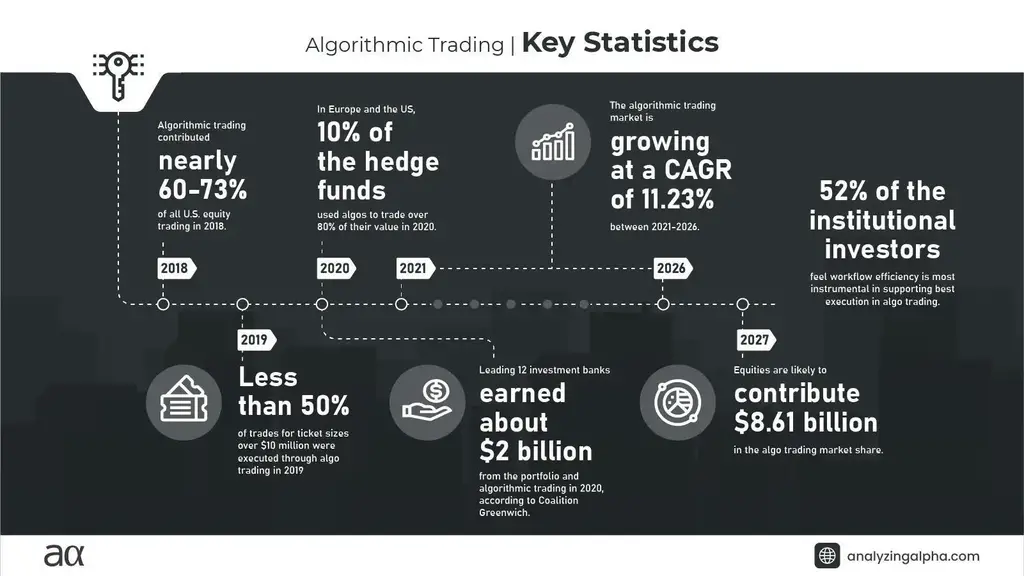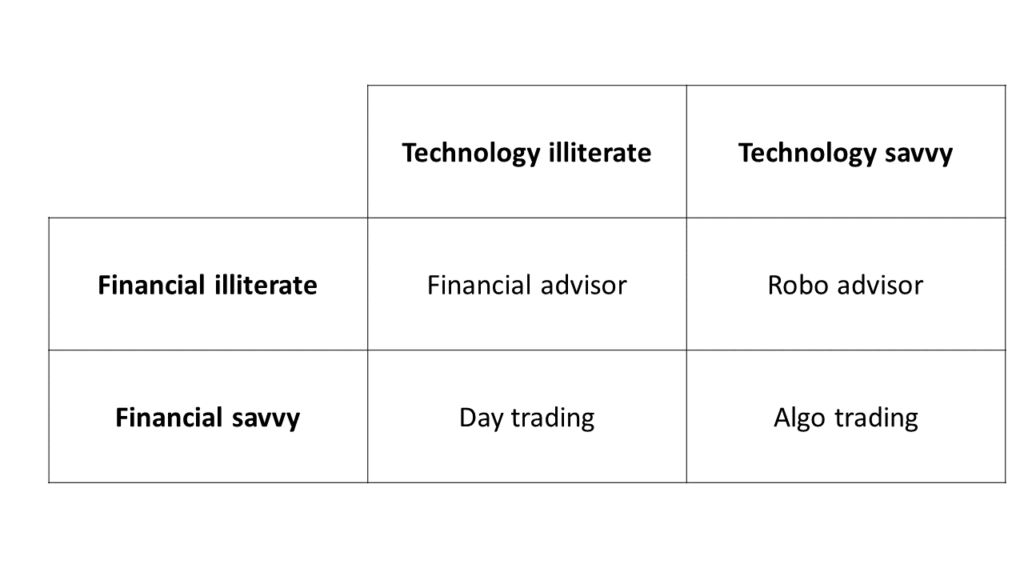The Art of Algorithmic Trading: my Guide to the Basics
Introduction
Algorithmic trading is the use of computer programs and technology to automate the process of buying and selling financial assets. This trading approach is also known as quantitative trading, algo-trading, or automated trading. Algorithmic trading contributed 60-73% of all US equity trading in 2018. In this blog post, I will provide an introduction to algorithmic trading and discuss the basics of this trading approach.

Table of Contents
- What is Algorithmic Trading?
- How Does Algorithmic Trading Work?
- Benefits of Algorithmic Trading
- Risks of Algorithmic Trading
- Common Types of Algorithmic Trading Strategies
- Tools and Platforms for Algorithmic Trading
- Getting Started with Algorithmic Trading
- Algorithmic Trading Courses and Training
- Final Words
- FAQ
What is Algorithmic Trading?
Algorithmic trading is a computer-based trading approach that utilizes pre-defined instructions or algorithms to automatically execute trades in financial markets. These algorithms are designed to analyze various market conditions, such as price trends, volume, and volatility, and identify profitable trading opportunities.
Algorithmic trading has become popular because it can help traders to execute trades with greater speed and accuracy than manual trading methods. Additionally, algorithmic trading can help traders to minimize emotions in trading decisions and improve risk management.
In my view, I categorize the various approaches to trading based on how comfortable you are with Technology and Finance. If you want to move towards savviness, do not underestimate the learning curve ahead of you. I have been in Technology roles my entire professional career and spent 3 years obtaining my CFA designation. Evaluate in which quadrant you belong before risking your money.

How Does Algorithmic Trading Work?
Algorithmic trading refers to the use of computer algorithms to automate the process of buying and selling financial instruments such as stocks, bonds, currencies, and commodities. These algorithms are designed to analyze vast amounts of data and execute trades based on pre-defined rules and conditions.
Here are the basic steps involved in algorithmic trading:
- Data Gathering: The first step in algorithmic trading is to gather data about the financial instrument being traded. This data can include historical price data, market news, economic indicators, and more.
- Strategy Design: Based on the gathered data, traders develop trading strategies that can generate profits. These strategies can be based on technical analysis, fundamental analysis, or a combination of both.
- Coding: Once the trading strategy is designed, it needs to be converted into code that can be executed by a computer. Traders use programming languages like Python or C++ to write the code.
- Backtesting: Before executing the strategy in real-time, it is important to test the strategy using historical data to see how it would have performed in the past. This is called backtesting.
- Execution: Once the strategy has been backtested and refined, it is time to execute the trades in real-time. The algorithmic trading system constantly monitors the market and executes trades based on the pre-defined rules and conditions.
- Risk Management: Risk management is a crucial component of algorithmic trading. Traders need to monitor the performance of their strategies in real-time and adjust them if necessary to minimize losses and maximize profits.
Overall, algorithmic trading allows traders to make faster, more precise, and more consistent trades than would be possible through manual trading. However, it requires significant technical expertise, as well as a deep understanding of the financial markets and trading strategies.
Benefits of Algorithmic Trading
One of the primary benefits of algorithmic trading is its ability to execute trades with speed and accuracy. Algorithmic trading systems can execute trades in milliseconds, which can help traders to take advantage of short-term price movements in the market.
Another benefit of algorithmic trading is its ability to minimize emotions in trading decisions. Trading decisions based on emotions can often lead to irrational behavior, such as over-trading or holding onto losing positions for too long. Algorithmic trading systems can help to eliminate these emotional biases and make trading decisions based on pre-defined rules and instructions.
My personal reason for using algo-trading for investing is that I do not have enough time to properly manage my portfolio, so the algo does it for me. I work a full-time, demanding job and cannot focus any energy on the markets during business hours.
Risks of Algorithmic Trading
Like any trading approach, algorithmic trading also comes with its own set of risks. One of the primary risks of algorithmic trading is the potential for technical failures. These failures can be caused by a variety of factors, such as hardware or software malfunctions, connectivity issues, or data errors. A typical error is the need to re-authenticate an algorithm as it is restarted, but I am not available at the time to accept the Multi-Factor Authentication (MFA) request.
Another risk of algorithmic trading is the potential for unexpected market events to impact trading decisions. Algorithmic trading systems are designed to operate under specific market conditions, and unexpected events can cause these systems to perform poorly or even fail completely. It’s been critical to have a lengthy dryrun beyond the backtest to ensure that my risk management and error handling are able to handle unexpected events.
Common Types of Algorithmic Trading Strategies
There are numerous algorithmic trading strategies, and they can be broadly classified into the following categories:
- Trend-following strategies: These algorithms identify market trends and take positions in the direction of the trend. For example, if the algorithm identifies an uptrend in a stock, it will buy the stock and hold it until the trend reverses.
- Mean-reversion strategies: These algorithms take positions in financial instruments that have deviated from their long-term average prices. The strategy assumes that prices will eventually revert to their mean, providing an opportunity to profit.
- Arbitrage strategies: These algorithms take advantage of price discrepancies between different financial instruments or markets. For example, if a stock is trading at a higher price on one exchange than another, the algorithm can buy the stock on the cheaper exchange and sell it on the more expensive exchange, earning a profit from the price difference.
- High-frequency trading (HFT) strategies: HFT algorithms use complex algorithms to execute trades at lightning-fast speeds, often in milliseconds or microseconds. These strategies rely on market data feeds, sophisticated mathematical models, and low-latency connections to exchanges to exploit small price discrepancies.
- News-based strategies: These algorithms use natural language processing (NLP) techniques to analyze news and other information sources to identify market-moving events. The algorithm can then take positions in financial instruments based on the expected impact of the news on the market.
- Sentiment analysis strategies: These algorithms use machine learning techniques to analyze social media, news articles, and other online sources to identify the sentiment of market participants. The algorithm can then take positions based on the expected impact of the sentiment on the market.
It is important to note that algorithmic trading strategies can be combined, modified, or customized to suit the specific needs of a trader or a hedge fund. Successful algorithmic trading strategies typically involve continuous backtesting, optimization, and refinement to adapt to changing market conditions.
A small piece of advice from my experience: keep it simple. It can be tempting to combine and create the perfect algorithm only to find that we’ve overfitted or cannot troubleshoot a bad trade.
Tools and Platforms for Algorithmic Trading
Traders can use a variety of tools and platforms to develop and execute their algorithmic trading strategies. Some popular tools and platforms for algorithmic trading include:
- Python and R programming languages
- Algorithmic trading libraries, such as PyAlgoTrade
- Trading platforms, such as MetaTrader or NinjaTrader or Quantconnect
- Cloud-based platforms, such as Amazon Web Services or Microsoft Azure
I have chosen to use Python with Quantconnect and Interactive Brokers as my broker. I will be going into more detail in another blog.
Getting Started with Algorithmic Trading
If you are interested in getting started with algorithmic trading, there are a few key steps that you should take. These include:
- Learning the basics of algorithmic trading (this blog is a good start)
- Choosing a trading strategy that aligns with your goals and risk tolerance
- Developing and testing your algorithmic trading strategy using backtesting or paper trading
- Choosing a broker or trading platform that supports algorithmic trading
- Deploying and monitoring your algorithmic trading strategy in a live trading environment
Algorithmic Trading Courses and Training
If you are new to algorithmic trading or want to improve your skills, there are a variety of courses and training programs available. These include online courses, books, and in-person workshops. Some popular algorithmic trading courses and training programs include:
I currently actively make use of IB’s resources for learning. I also very much appreciated Udemy’s courses.
Final Words
Algorithmic trading is a popular trading approach that utilizes computer programs and technology to automate the process of buying and selling financial assets. This trading approach can help traders to execute trades with greater speed and accuracy, minimize emotions in trading decisions, and improve risk management. However, algorithmic trading also comes with its own set of risks and requires careful planning and testing. By following the steps outlined in this blog post, you can get started with algorithmic trading and begin to take advantage of its benefits.
FAQ
- How do I choose a broker or trading platform for algorithmic trading? When choosing a broker or trading platform for algorithmic trading, it is important to consider factors such as the platform’s compatibility with your trading strategy, the availability of historical data for backtesting, and the platform’s fees and commissions.
- Can I use algorithmic trading for all types of financial assets? Algorithmic trading can be used for a variety of financial assets, including stocks, bonds, commodities, and currencies. However, the effectiveness of algorithmic trading may vary depending on the specific asset and market conditions.
- Are there any regulations governing algorithmic trading? Yes, there are regulations governing algorithmic trading in many countries. These regulations are designed to promote market stability and prevent unfair practices. Traders who use algorithmic trading should be aware of the regulations in their jurisdiction and ensure that their trading strategies comply with these regulations.
